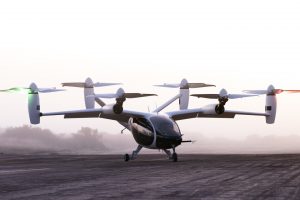The New Uber?
Written by: Avyay Duggirala
Uber and other rideshare companies have become immensely popular in the last couple of years. But, regardless of whether you are getting in an Uber or even driving yourself, one problem still exists – traffic. However with the new technology created by JOBY(a partner of NASA), Air Taxis, which would take travel to new heights, might become a reality. NASA recently tested these all-electric Air Taxis in flight and they flew more than 150 miles successfully, meaning that they can move on to the next stage of testing and eventually be rated for customer use.
What is it?
This air taxi, which is essentially a crossover of a car and helicopter, was created by a company named JOBY, who recently partnered with NASA due to their groundbreaking work with electric flight projects. Their goal is to create a safe, efficient, and non-polluting form of air transportation that is accessible to everyone. They recently finished their prototype and have just started to test it out. So far, the taxi has been very successful and flew more than 70 miles.
As for how this plans to work, NASA’s AAM (Advanced Air Mobility Project) has shared an outline. Their initial goal, once this “air taxi” passes all protocols, is to create a network of aircrafts to transfer cargo. This network will be used for NASA to monitor the safety and efficiency of these aircraft. Then, once deemed safe enough, these planes will also be integrated into an Uber-like network. JOBY and NASA’s long-term plan is to create a rideshare system like Uber and Lyft to the final goal of actually moving people, diminishing the effect of traffic on users of this system.
Figure 1

Picture of the new air taxis
[NASA]
Future Impacts
An innovation of this magnitude will lead to massive changes to the way society views transportation. People will no longer have to worry about things like traffic, as they can take the bus, walk, drive or even fly. The Air Taxi can also become a major industry similar to that created by current ride-share companies, which would open up hundreds of potential job opportunities. This also means that we are closer than ever to potentially having flying cars or maybe even things like floating roads by using the same technology like that from the Air Taxis. Finally, we can use the zero-emission lithium batteries used by these Air-Taxis to power other forms of transportation and reduce our ecological footprint.
Figure 2

An Air Taxi Preparing for Takeoff
[NASA]
Conclusion
The future is closer than we think, and with amazing ideas and inventions like these, we learn more than we have ever known. The technology used is a result of hard work and dedication and will lead to hundreds of job opportunities and a cleaner and faster form of transportation. The Air Taxi is set to start its taxi service sometime around 2024, so look to the sky, as it may soon be filled with Air Taxis.
References and Sources
Joby. (2021). Our story: Joby. Joby Aviation. Retrieved October 20, 2021, from http://www.jobyaviation.com/about/.
Margetta, R. (2021, September 1). NASA begins air taxi flight testing with Joby. NASA. Retrieved October 20, 2021, from http://www.nasa.gov/press-release/nasa-begins-air-taxi-flight-testing-with-joby.
Reichmann, K. (2021, July 29). Joby completes longest evtol test flight to date. Aviation Today. Retrieved October 20, 2021, from http://www.aviationtoday.com/2021/07/29/joby-completes-longest-evtol-test-flight-date/.
Smith, Y. (2021, September 14). Air Taxi Flight Testing. NASA. Retrieved October 20, 2021, from http://www.nasa.gov/image-feature/air-taxi-flight-testing.